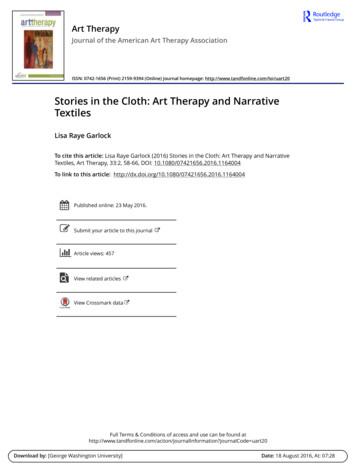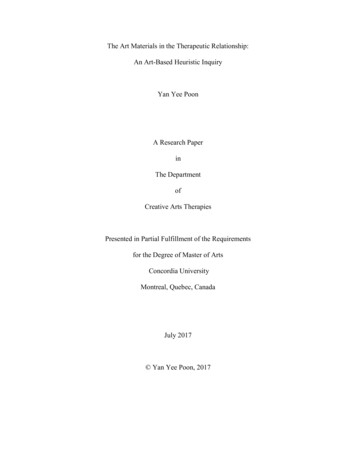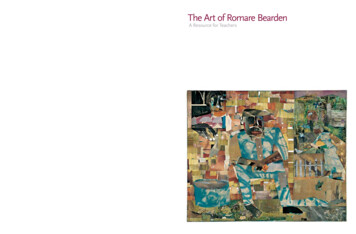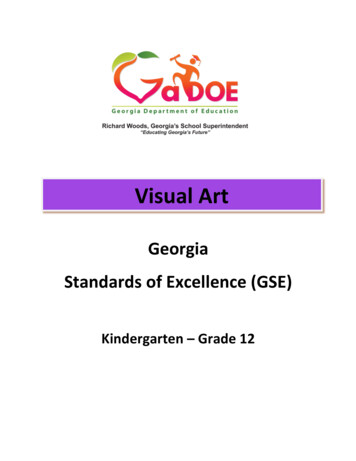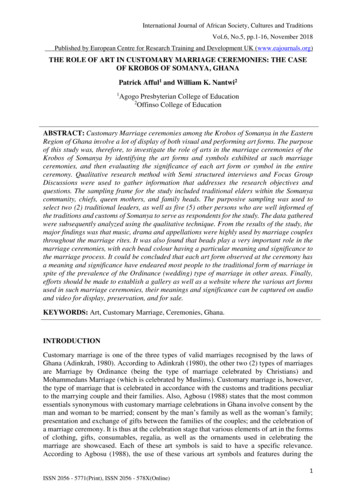
Transcription
International Journal of African Society, Cultures and TraditionsVol.6, No.5, pp.1-16, November 2018Published by European Centre for Research Training and Development UK (www.eajournals.org)THE ROLE OF ART IN CUSTOMARY MARRIAGE CEREMONIES: THE CASEOF KROBOS OF SOMANYA, GHANAPatrick Afful1 and William K. Nantwi21Agogo Presbyterian College of Education2Offinso College of EducationABSTRACT: Customary Marriage ceremonies among the Krobos of Somanya in the EasternRegion of Ghana involve a lot of display of both visual and performing art forms. The purposeof this study was, therefore, to investigate the role of arts in the marriage ceremonies of theKrobos of Somanya by identifying the art forms and symbols exhibited at such marriageceremonies, and then evaluating the significance of each art form or symbol in the entireceremony. Qualitative research method with Semi structured interviews and Focus GroupDiscussions were used to gather information that addresses the research objectives andquestions. The sampling frame for the study included traditional elders within the Somanyacommunity, chiefs, queen mothers, and family heads. The purposive sampling was used toselect two (2) traditional leaders, as well as five (5) other persons who are well informed ofthe traditions and customs of Somanya to serve as respondents for the study. The data gatheredwere subsequently analyzed using the qualitative technique. From the results of the study, themajor findings was that music, drama and appellations were highly used by marriage couplesthroughout the marriage rites. It was also found that beads play a very important role in themarriage ceremonies, with each bead colour having a particular meaning and significance tothe marriage process. It could be concluded that each art form observed at the ceremony hasa meaning and significance have endeared most people to the traditional form of marriage inspite of the prevalence of the Ordinance (wedding) type of marriage in other areas. Finally,efforts should be made to establish a gallery as well as a website where the various art formsused in such marriage ceremonies, their meanings and significance can be captured on audioand video for display, preservation, and for sale.KEYWORDS: Art, Customary Marriage, Ceremonies, Ghana.INTRODUCTIONCustomary marriage is one of the three types of valid marriages recognised by the laws ofGhana (Adinkrah, 1980). According to Adinkrah (1980), the other two (2) types of marriagesare Marriage by Ordinance (being the type of marriage celebrated by Christians) andMohammedans Marriage (which is celebrated by Muslims). Customary marriage is, however,the type of marriage that is celebrated in accordance with the customs and traditions peculiarto the marrying couple and their families. Also, Agbosu (1988) states that the most commonessentials synonymous with customary marriage celebrations in Ghana involve consent by theman and woman to be married; consent by the man’s family as well as the woman’s family;presentation and exchange of gifts between the families of the couples; and the celebration ofa marriage ceremony. It is thus at the celebration stage that various elements of art in the formsof clothing, gifts, consumables, regalia, as well as the ornaments used in celebrating themarriage are showcased. Each of these art symbols is said to have a specific relevance.According to Agbosu (1988), the use of these various art symbols and features during the1ISSN 2056 - 5771(Print), ISSN 2056 - 578X(Online)
International Journal of African Society, Cultures and TraditionsVol.6, No.5, pp.1-16, November 2018Published by European Centre for Research Training and Development UK (www.eajournals.org)celebration of customary marriage has various connotations which may also differ from onetradition, ethinic group or community to the other. Thus, generally, it has been observed thatvarious communities within Ghana have their unique ways of celebrating their customarymarriage rites. It is however worth noting that in spite of the fact that the celebration of eachcustomary marriage rite may be unique to a particular ethinic group or traditional area, theapparent use and display of art has been observed to be a common feature in these celebrations,irrespective of the tribe or traditional area where the marriage is celebrated. For instance theAnlo people, Dagombas, Nzemas, Krobo, among others all have very artistic ways by whichthey celebrate their customary marriages. It is therefore to be expected that the array of artforms and symbols displayed as such functions, irrespective of the origins of the couple andtheir families, do have certain relevance that are worth researching into. In the case of theKrobos, Huber (1993) reveals that the people of Krobo migrated together with other Dangmespeaking people from Sameh in the Benin republic (formerly Dahomey) to their presentlocation. Wars, farming and trade however led the settlement on various lands, includingsettlement in Somanya by a section of the Krobo people. Naturally, these settlors have beenengaging in their peculiar form of marriage from the ancient times up to today. During suchmarriage rites, a number of art elements are similarly seen on the marriage couples, theirfamilies and guests during such marriage rites. These adornments are hugely made up of beadsand woven kente cloth (Huber, 1993). Other elements of art are also present and showcased bythe couple and their families during the marriage rites. From the foregoing, it can be said thatthe celebration of customary marriage rites among the Krobos presents an opportunity for theshowcasing of their rich artistic values and customs. The legitimate question that may thusfollow is, what then is the role of art in the celebration of customary marriages rites? This studythus intends to unravel the role that art plays in customary marriage rites, using the marriageceremony among the Krobos of Somanya in the Eastern region of Ghana as a case study. A lotof art and artefacts feature prominently during the marriage ceremonies of the Krobos.However, in spite of the apparent display of art and several features of art during the marriageceremonies of the Krobos of Somanya, not much is known by the academic world relative tothe significant role that art plays in the celebration of the entire marriage process. Thesignificant role of art in the marriage process which is, expectedly, known by the celebrantsand the people from the Krobo land is however unknown by the academic world. Within theacademic circles, what is described as the significant role of art in the marriage rites can, atbest, be described as mere speculations as the researcher could not come across any empiricalresearch that explains the role of art in the celebration of the customary marriage rites amongthe Krobos of Somanya. The absence of such a scientific enquiry into the role of art in theKrobos marriage ceremonies can therefore be considered as a gap in knowledge. It is thereforethis gap in knowledge that this study seeks to fill.Objectives of the StudyThe main objective of this study is to assess the role that art plays in the marriage ceremoniesof the people of Krobos, using celebrations at Somanya as the case study. The specificobjectives of the study are, however, toa) Examine the marriage ceremonies of the Krobos in Somanyab) Identify and describe the art forms and symbols associated with the ceremonies, andc) Evaluate the significance of such art forms and symbols in the ceremony.2ISSN 2056 - 5771(Print), ISSN 2056 - 578X(Online)
International Journal of African Society, Cultures and TraditionsVol.6, No.5, pp.1-16, November 2018Published by European Centre for Research Training and Development UK (www.eajournals.org)Research QuestionsIn order to achieve the above stated objectives, the study seeks to find answers to the followingquestions:a) How do the Krobos of Somanya celebrate their marriage ceremonies?b) What are the art forms and symbols associated with the marriage ceremonies? andc) What are the significance of art forms and symbols in the marriage ceremony?LITERATURE REVIEWConcept of Marriage in GhanaIn Ghana, there are three main types of marriages. These are customary marriage, Marriageunder Ordinance and Mohammedans. Both Marriage under Ordinance and Mohammedans arealso referred to as statutory marriages. Statutory marriage is of a comparatively recent originand is confined mainly to educated young people in towns and cities. It has been clearlyconsidered that customary marriage is still the most predominant form of marriage in Ghana.Dzobo (1975) defines marriage as ‘one of the supreme aims of life in the traditional societyand as a union between man and woman to perpetuate the lineage through procreation’.Marriage, he noted, has been instituted as the acceptable and respectable mode of ensuring thecontinuity of the family line. He again opines that an individual’s life is therefore not completeif he remains unmarried. A man may therefore marry more than one woman if he feels that hislife is not brought to consummation by marring one woman. Marriage also has an extra socialmeaning for women besides the general aims. Usually, a woman's status in marriage is furtherenhanced when she has children. Women therefore consider it a personal tragedy if they cannothave babies. Dzatse (1990) emphasizes marriage as a desirable institution among Ghanaiansfor ensuring the perpetuation of the lineage for self-fulfillment and companionship. Dzatse(1990) also recounts that marriage is considered as a form of an intimate personal relationshipbetween man and woman and it needs a lot of interpersonal adjustment. Mbiti (1991:108) alsodescribes the African concepts of marriage as, ‘to Africans, marriage is the focus of existence.It is the point where all the members of a given community meet the departed, the leaving andthose yet to be born. All the dimension of time meets here and the whole drama of history isrepeated, renewed and revitalized. Marriage is a drama in which everybody becomes an actoror actress and not just a spectator: Therefore, marriage is a duty, a requirement from thecorporate society and a rhythm of life in which everyone must participate and not a spectator.Otherwise, he who does not participate in it is a curse to the community, he is a rebel and alaw-breaker and he is not only abnormal but under-human. Failure to get married under normalcircumstances means that, the person concerned has rejected society, and society rejects himalso in return. Salm (1996) in Culture and Customs of Ghana also states that, unlike marriagein many other parts of the world, marriage in Ghana in seen as a requisite stage in life, ratherthan an option, and remains the most important social institution. Marriage sanctions,reproduction is still believed by many to be the most important function of the union betweena man and woman. Children are signs of status and wealth. They represent a successfulmarriage, provide valuable domestic help around the house, and can contribute to agriculturallabour. Marriages between individuals from outside their kinship group are most commonunder customary law. Through this marriage, new social contacts are made and kinship ties are3ISSN 2056 - 5771(Print), ISSN 2056 - 578X(Online)
International Journal of African Society, Cultures and TraditionsVol.6, No.5, pp.1-16, November 2018Published by European Centre for Research Training and Development UK (www.eajournals.org)extended. Marriage therefore, serves to establish alliances between families and betweencommunities. Magesa also in his article titled ‘The honour of marriage in Africa’ shares theunderstanding and value of marriage within the African settings, concluding that within thecontext of African traditional marriages, marriage is a permanent, stable, sexually exclusive,unity-seeking and unity-generating commitment of love between a man and a woman, formutual fulfillment, happiness and meaning, and opens to the generation of offspring. These, hethinks are quite common in both Christian and traditional African marriages. Sarpong (1974)also re-affirms that basically, ideas about marriage are all the same all over the world.According to him, everywhere in the world, people leave their mothers, sisters and otherrelatives in order to enter into alliance with some ‘strange’ person. They cannot be said simplyto be seeking consolation or soliciting help. One would get better help, and solace from one'sown relatives. It is therefore reasonable to suggest that the main aim of marriage is to have thatsexual access to a person which would not be deemed proper in the case of relation. Sarpongwent on to stress that examination of the male and female sex organs shows that those of theone are designed to be used with those of the other sex. Unlike such faculties as the eye or theheart which are employed exclusively for one's own benefit, they have altruistic utility. Heagain emphasized that in Africa, marriage is hardly a personal affair. It is a matter in which thelineages of the contracting parties are greatly interested. In a way, every marriage concerns thewhole society in which it takes place, for which reason, all societies lay down rules regulatingthe use of sex in general and of marriage in particular. It has been noted by the reviewer thatthe main reasons for customary marriage in Ghana and for that matter in Krobo traditionalsociety are, firstly, to marry, live together and procreate: for the children to receive adequateparental care from both parents. It was realized that often, some single parents were caughtbetween undertaking economic activities for their upkeep and taking care of their children.Where both parents are available, however, one of the parents is always at hand to offer theneeded parental care that often eludes single parents. The second reason is to marry in order tocommand respect and social standing in the society that one belongs to. Another reason is tocontinue with the lineage as an institution or the formation of new families in order to cometogether for lineages to be preserved. Children who come out from marriages, as fruits of lifeare also considered as wealth and value, not only to the biological parents, but also to thecommunity in which they are born into, and to Ghana as a whole. Therefore, it is a paramountresponsibility of everybody to see to it that the child is brought up in a proper responsiblemanner for the good of the society at large. Another essence of traditional customary marriagein the Krobo traditional society is to serve as a uniting link in the rhythm of life. Generationsin Krobo are said to be bound together in the act of marriage-past, present and futuregenerations. The past generations are many but they are represented in one's own parents, thepresent generation is represented in one's own life, and future generations begin to come on thestage through childbearing. It is also a very tragic thing when no children come out of amarriage. Then people do not consider it to truly a marriage, and other arrangements are madeto obtain children in the family. Through these arrangements, the children are rememberedwhen their parents die. Anyone who dies without having anyone behind him to pour outlibations for him is a very unfortunate person. Therefore, marriage is intimately a confirmationof life beyond death. Marriage is also regarded by the Krobos as the counter-measure againstthe lost immortality myths. Through marriage the departed are in effects reborn not in theirtotal being but by having some of their physical treasures and characteristics or personalitytraits reborn in the children of the family. If no children were born these traits and features ofthe departed members of the family would not be seen again. While death takes awayindividuals one by one, and disperses families, the purpose of marriage, according to Krobocustom, is to bring people together, to increase them, to multiply them and to keep them alive.4ISSN 2056 - 5771(Print), ISSN 2056 - 578X(Online)
International Journal of African Society, Cultures and TraditionsVol.6, No.5, pp.1-16, November 2018Published by European Centre for Research Training and Development UK (www.eajournals.org)Types of art forms and symbols in customary marriagesAccording to Huber (1993), there are various forms and symbols of art that are displayedbefore, during and after customary marriage ceremonies. He opines that these art forms maycome in the form of music, dance, musical instruments and even types of dance showcased atsuch ceremonies. It is Huber’s opinion that even the type of dance that is exhibited by couples,families and guests during such celebrations may have a meaning that is peculiar to themarriage occasion. Such art forms exhibited during marriage ceremonies may differ frommusic and dance forms that are showcased at say funerals, child naming ceremonies and othercustomary events. In support of this position, Ashe (2012) reveals that marriage ceremonieshave been identified within a number of customs, particularly in Africa, as occasions thatpresent opportunity for members of the society to portray their art and culture to the outsideworld. Ashe (2012) lists some of these art form to include painting of the body, music anddance. Ashe however adds a number of symbols such as beads, jewelry, sculpture, specialclothing and other artefacts as some of the essentials of customary marriage displays within anumber of African setting. Within the Ghanaian context however, not much have been writtenin relation to a number of the various ethnic groups found in Ghana. According to Antubam(1963) married couples during the customary marriage rites among a number of traditionalgroups in Ghana use all types of artifacts ranging from jewels, rings, beads, necklaces, potteryitems; bowls, vases, silver wares and foot wears. Drama, dance and poetry are performedduring such customary marriage ceremonies.Meaning and significance of art forms and symbols in customary marriagesA number of literature reviewed pointed to the fact that the various art forms and symbols usedduring the celebration of customary marriage rites portray certain meanings, most of whichwere found to be largely similar among the various ethnic groups. For instance Dzobo (1975)writes that the ayawagba, an iron pot, gifted to the bride during the marriage rite of Ewe peoplesignify wealth of parents of the couples or the couples themselves. In those circumstances,couples or parents of couples who owned such customary ‘ayawagba’ showed that such personswere very influential and wealthy members of the community. Another art form that is usedamong the Akans and some sects of Ewes is the presentation and sitting of the bride on a giftedtraditional stool during the celebration of the customary marriage rites. Edusei (1991) gives anaccount of what another art form used in during the marriage ceremony – the coiffure or hairdo– symbolizes. He explains that in most of traditional marriages, the type of hair style a bridehas during the ceremony enhances her beauty and prestige for the event. It is also a symbol ofdeep rooted standing into her new marital home. The wearing of beads during the celebrationof customary marriage rites is yet another art form whose significance has been explained by anumber of literature. Wilson (2003) explains that beads can be worn around the neck just foradornment and day-to-day wear, but more importantly they should be worn for festivals,durbars, and going to church. Marriage ceremonies therefore witness the wearing of beads bythe couple, family members and guests. Ashe (2012) also explains the significance of thewearing of beads during the celebration of marriage rites. She explains the adornment as asubtle presence that arouses passion in men, and that the wearing of beads is used by a womanto indicate her desire for lovemaking by rattling her waist beads. Such an act was expresslymeant for the man she was married to; it was considered great slander for a woman to describeher waist beads to any other man (Francis Jr., 1993). At this stage, the adornment of the beadsgoes on with selected special dressing of the rite and the entire invited guests. Wilson on theother hand explains that marriage is also a rite of passage that features the use of beads. Both5ISSN 2056 - 5771(Print), ISSN 2056 - 578X(Online)
International Journal of African Society, Cultures and TraditionsVol.6, No.5, pp.1-16, November 2018Published by European Centre for Research Training and Development UK (www.eajournals.org)the bride and groom wear multiple strands of old heirloom beads to both display their identityas a Krobo couple, and demonstrate their wealth. It is customary for the bride to change outfitsthroughout the traditional wedding ceremony, to show she is entering a new state (Kumekpor1995).METHODOLOGYThe study adopted the qualitative research design, and relied on the case study method ofgathering data. Semi structured interviews and Focus Group Discussions were used to gatherinformation that addresses the research objectives and research questions. The sampling framefor the study included traditional elders within the Somanya community, chiefs, queen mothers,family heads, as well as couples who got married through customary ceremonies. Thepurposive sampling techniques was used to select two (2) traditional leaders, as well as five (5)other persons who are well informed of the traditions and customs of Somanya to serve asrespondents for the study. The data gathered were subsequently analyzed using the qualitativetechnique of content analysis.DISCUSSION OF FINDINGS AND RESULTSResearch Question One (1)How do the Krobos of Somanya celebrate their marriage ceremonies?This section is in line with the first research question of the study, it provides discussions onthe marriage ceremony of the Krobos of Somanya through information gathered frominterviews and focus group discussion. The information gathered is compared and contrastedwith what was personally observed by the researchers during two marriage ceremonieswitnessed at Somanya. There are four stages involved in the customary marriage among theKrobos, namely; courting, knocking, payment of dowry and engagement. On account of thesefour procedures, two traditional elders namely Naa Oniko Atiawe and Tsiame Osu Tettehprovided a vivid account of the various stages, which was then compared and contrasted withthe information gathered from the focus group discussion. The information gathered in respectof the various stages of ceremony was also compared and contrasted with what the researchersindividually observed at the functions. As gathered from the respondents and also witnessedby the researchers, these four (4) stages in the marriage process were all illustrated at theceremony through enactments of drama and a lot of poetry of recitals.Dating / Courtship StageIt was found that courtship or dating was a prelude to actual marriage, in satisfaction of thecustomary requirement that men and women should date or court for a while before decidingto settle down to marriage. It was explained that among the Krobos, the act of courting sets thetone for learning to please each other in marriage. Naa Oniko explained that the wisdom behindthe courting is to give the potential couple adequate time to study each other. Courting thereforehad to be done under the strict supervision by the parents of the bride and groom as well as theelders of the community. The discussants believed that the courtship enabled them to bepsychologically and emotionally matured before their actual marriage. This disclosure seems6ISSN 2056 - 5771(Print), ISSN 2056 - 578X(Online)
International Journal of African Society, Cultures and TraditionsVol.6, No.5, pp.1-16, November 2018Published by European Centre for Research Training and Development UK (www.eajournals.org)to confirm the position held by a number of anthropologist who have researched contemporarytraditional marriages that the advent of grooms looking for their own brides, which is adeparture from the previous practice where parents got involved in selecting their would-bepartners, justifies why there should be dating or courting so that couples would knowthemselves before actual marriage.Knocking StageThe second stage is the ‘knocking stage’. Naa Oniko explained knocking as an agreementbetween the groom and his family on one hand and the bride and family on the other hand thatthe couple intend to marry after the exercise of courtship. Over here, the man and his familythen follow up to the bride’s house to see the bride’s parents. It was revealed that usually, twoto four family members of the groom are sent to the bride’s parents to ask for the hand of thebride in marriage. It is at this point that a fee is demanded and paid. Again, for the Krobos ofSomanya, before a girl marries she is expected to have gone through puberty rites known as“Dipo”. This is done to usher her into new stage of life and was explained by Naa Oniko as:“We believe that the life of a human being is a development process that involves several stagesfrom conception to death with each stage having significant effects on the individual and alsothe society. We recognise the puberty stage as one of the stages that is markedly different fromall other stages. The rites observed when our ladies attains puberty therefore ensure a safepassage from childhood to adulthood. The initiates are also taught how to perform their rolesas responsible adults. After being ushered into adulthood, we believe the girl can now bemarried off to a deserving suitor.” This procedure of transitioning a girl from childhood hasbeen commented on by researchers and commentators to be a common feature in most of thetraditional systems in Ghana. For instance, Salm and Falola (2002) state that all traditionalGhanaian societies celebrate girls’ transition to adulthood and it is known as otufo among theGas, bragor כ among the Akans and dipo among the Krobos. Nukunya (2003) also mentionsthat a similar practice is found among the Ewes though it appears to be unknown in the northernparts of Ghana. However, Sackey (2001) states that puberty rites are held for both boys andgirls in the Northern Region of Ghana unlike the south where it is mainly for girls. In an articleby the Ghana News Agency (2004), it is mentioned that in the Upper East Region, situated inNorthern Ghana, female genital mutilation is actually practiced as a form of puberty rites.According to Salm and Falola (2002), Ghanaians today do not go through the same initiationrites as their elders, and this is mainly because such rites have gradually faded out with theexception of the Dipo which is now the most elaborate rite of passage in Ghana.Tsiami Tetteh also added,“The Dipo ritual does not involve any genital cutting or test of physical endurance. EveryKrobo girl is expected to go through these rites else she will never be fully recognized as aKrobo woman. And if you are not a fully grown woman, you obviously cannot enter into a validmarriage.”Huber (1963) illustrates this fact when he states that there is the strongest of conviction, datingfrom ancient times, that, no Krobo girl can even become a mature Krobo woman and a wifeworthy of a Krobo man, unless she can show on her body and on her hands the visible marksof her initiation.7ISSN 2056 - 5771(Print), ISSN 2056 - 578X(Online)
International Journal of African Society, Cultures and TraditionsVol.6, No.5, pp.1-16, November 2018Published by European Centre for Research Training and Development UK (www.eajournals.org)Payment of Dowry StageAt this stage, the groom anticipating to marry is provided a list of items that he is required topresent to the bride and her family when coming to perform the customary rite. Throwing morelight on the procedure, Tsiami Tetteh explained that this procedure which comes just beforethe actual traditional marriage celebration could actually be performed together with the actualcelebration itself. This view was confirmed by Naa Oniko, the discussants at the groupdiscussion as well as personally witnessed by the researcher. Tsiami Tetteh explained that thepayment of the dowry by the groom is subdivided into four (4) steps. From the data gatheredas well as the observations made personally, the entire four subdivisions of dowry payment canbe represented as followsStep one (1)a) Sihw כ mi – Sleeping (one (1) bottle of Akpeteshie – a local alcoholic beer)b) Sitlemi – Waking-up (one (1) bottle of Akpeteshie)c) Hemif כ mi – Washing of face (two (2) bottles of Beer)d) Ngami – Greeting (one (1) bottle of Schnapps)Step two (2)e) Hesijemi – Introduction (two (2) bottle of Schnapps)f) Yobami – Borrowing of the bride (two (2) bottle of Schnapps)Step three (3)g) Wekusitome asika – Money for the family (unspecific amount is paid)h) Abgosimi – knocking (one (1) bottle of Schnapps)i) Wemis כ mi – entering the house (two (2) bottle of Schnapps)j) Yosibimi – asking the lady in-hand for marriage (two (2) bottle of Schnapps)k) Yos כ lemi – receiving the bride (two (2) bottle of Schnapps)l) Yonyasinami – showing of appreciation (two (2) bottle of Schnapps)m) Yonyastumihami – showing another appreciation to the entire family (two (2) bottleof foreign Schnapps)n) Wekubiasika – money for the family (after everything)(unspecific amount is paid)o) Baj כ me asika – money for the brothers-in-law (unspecific amount is paid)p) (i) Ngats כ bokpo – full piece of cloth, two (2) cutlasses, one (1) umbrella and one (1) ofnative sandals (Ablade) for the father-in-lawq) Ngany כ semf כ mi – money for the mother-in-lawr) Mats כ da – drink for the chief in the town (one (1) bottle of Schnapps)8ISSN 2056 - 5771(Print), ISSN 2056 - 578X(Online)
International Journal of African Society, Cultures and TraditionsVol.6, No.5, pp.1-16, November 2018Published by European
Both Marriage under Ordinance and Mohammedans are also referred to as statutory marriages. Statutory marriage is of a comparatively recent origin and is confined mainly to educated young people in towns and cities. It has been clearly considered that customary marriage is still the most predominant form of marriage in Ghana.








